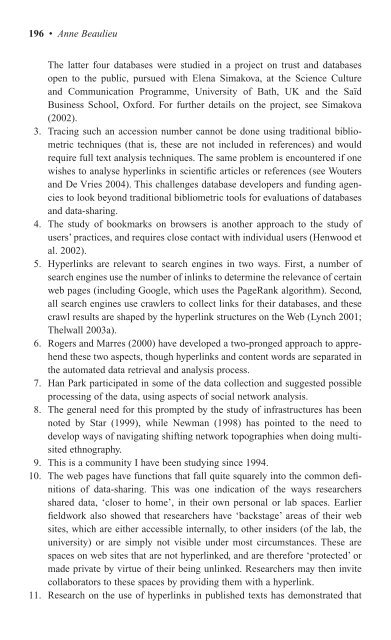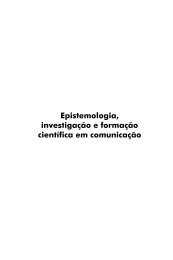Virtual Methods
Virtual Methods
Virtual Methods
Create successful ePaper yourself
Turn your PDF publications into a flip-book with our unique Google optimized e-Paper software.
196 • Anne Beaulieu<br />
The latter four databases were studied in a project on trust and databases<br />
open to the public, pursued with Elena Simakova, at the Science Culture<br />
and Communication Programme, University of Bath, UK and the Saïd<br />
Business School, Oxford. For further details on the project, see Simakova<br />
(2002).<br />
3. Tracing such an accession number cannot be done using traditional bibliometric<br />
techniques (that is, these are not included in references) and would<br />
require full text analysis techniques. The same problem is encountered if one<br />
wishes to analyse hyperlinks in scientific articles or references (see Wouters<br />
and De Vries 2004). This challenges database developers and funding agencies<br />
to look beyond traditional bibliometric tools for evaluations of databases<br />
and data-sharing.<br />
4. The study of bookmarks on browsers is another approach to the study of<br />
users’ practices, and requires close contact with individual users (Henwood et<br />
al. 2002).<br />
5. Hyperlinks are relevant to search engines in two ways. First, a number of<br />
search engines use the number of inlinks to determine the relevance of certain<br />
web pages (including Google, which uses the PageRank algorithm). Second,<br />
all search engines use crawlers to collect links for their databases, and these<br />
crawl results are shaped by the hyperlink structures on the Web (Lynch 2001;<br />
Thelwall 2003a).<br />
6. Rogers and Marres (2000) have developed a two-pronged approach to apprehend<br />
these two aspects, though hyperlinks and content words are separated in<br />
the automated data retrieval and analysis process.<br />
7. Han Park participated in some of the data collection and suggested possible<br />
processing of the data, using aspects of social network analysis.<br />
8. The general need for this prompted by the study of infrastructures has been<br />
noted by Star (1999), while Newman (1998) has pointed to the need to<br />
develop ways of navigating shifting network topographies when doing multisited<br />
ethnography.<br />
9. This is a community I have been studying since 1994.<br />
10. The web pages have functions that fall quite squarely into the common definitions<br />
of data-sharing. This was one indication of the ways researchers<br />
shared data, ‘closer to home’, in their own personal or lab spaces. Earlier<br />
fieldwork also showed that researchers have ‘backstage’ areas of their web<br />
sites, which are either accessible internally, to other insiders (of the lab, the<br />
university) or are simply not visible under most circumstances. These are<br />
spaces on web sites that are not hyperlinked, and are therefore ‘protected’ or<br />
made private by virtue of their being unlinked. Researchers may then invite<br />
collaborators to these spaces by providing them with a hyperlink.<br />
11. Research on the use of hyperlinks in published texts has demonstrated that



